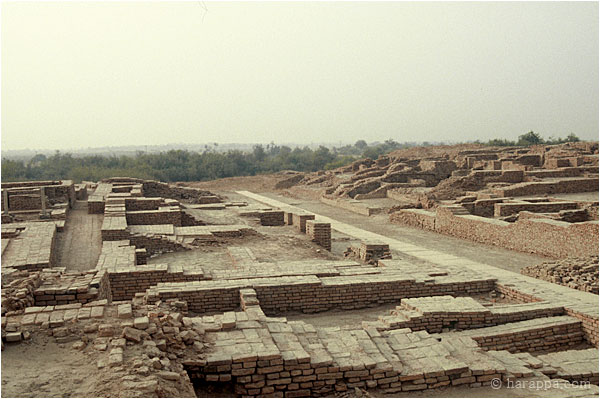Mohenjo-Daro: The room with the so-called massacre victims is on the west side of the street (at the right edge of the photo).
Gregory L. Possehl in The Indus Civilization - A Contemporary Perspective summarizes various theories forwarded by previous authors on why and how the Indus Civilization ended, leading to the period from 1900 BC to the Iron Age (around 1000 BC), when there was essentially no habitation in Mohenjo-daro, Harappa and other urban centers, there was a disruption in the economy, luxury items like long barrel-cylinder beads, etched beads and inscribed stamp seals disappeared, the art of writing was no longer practiced, long-distance trade was reduced, and the distribution of human population shifted (reduction of population in the Sindh areas and an increase in population in the areas from Punjab to Rajasthan).
Theory 1: Wheeler’s Aryan Army
Rigveda conflicts can be viewed as between newly arrived Aryan warriors and the indigenous Indus peoples. Climatic, economic, political deterioration may have weakened it, but its ultimate extinction is more likely to have been completed by deliberate and large-scale destruction – a Late Period of Mohenjo-daro men, women and children appear to have been massacred there (Mackay 1937), but it has also been argued that the remains found are not of massacre victims but actually hasty interments.
Theory 2: Wearing out the Landscape
Ecological basis. Millions of tons of firewood went into baking millions of baked bricks for building and rebuilding Mohenjo-daro. This implies a widespread deforestation of the surrounding region. Contrary views argue that only 400 acres of gallery forest would have been needed for rebuilding Mohenjo-daro every 140 years.
Theory 3: Avulsion of the Indus River
Natural cause of dramatic shift in the course of the Indus River – led to abandonment of Mohenjo-daro, and by domino effect the rest of the Indus Civilization was eclipsed.
Theory 4: The Raikes/Dales Dam
A natural dam near Sehwan impounded the waters of the Indus River and caused heavy flooding (to a degree beyond normal behavior of a river), leading to disruption of Mohenjo-daro and other sites. This view is critiqued by the opinion that a natural dam could not have been formed by the sediments of the Indus Civilization because of its low structural integrity. It is also opposed by the view that an impounded Indus River was not sufficient to end the civilization.
Theory 5: The Lost Sarasvati
The waters from the Sarasvati and Drishadvati Rivers dried up, the Himalayan waters instead created the Yamuna river, possibly supported by tectonic upheaval – this happened at the expense of the greater Indus system. Alongside, a sociocultural cause was assumed to be occurring (like renewed settlement in northern Rajasthan with evolved technology), and together led to the demise of the Indus Civilization.
Theory 6: Climatic Change
Changing salinity in lakes would have affected agriculture, but because it would not necessarily imply changes in rainfall and because it was a dry-crop region, this theory does not hold much water.
Theory 7: Allchins’ Approach
Economic factors (decline of Mesopotamian trade), steady deterioration in climate (reduction in rainfall) and environment, uplift of the Himalayas due to tectonics causing change in course of the Indus system rivers. This view is countered by opinions that the foreign trade did not really get interrupted, alternatively that the trade decline wasn’t the cause but effect of the Indus Civilization decline; an additional argument against the Allchins’ approach is that Mohenjo-daro;s agriculture was geared towards and thrived in a desert climate, so that a reduction in rainfall was not an impactful natural cause.
“There is a historical awkwardness on two counts: There is a period of eclipse with a growth of human habitation; and a proposed aridity at a time when archaeological data indicate widespread dry cropping.”
Author Gregory L. Possehl’s forwards his hypothesis that the cause of the decline of the Indus Civilization was at its heart, its ideological core: nihilism, urbanization and sociocultural complexity (iconographic themes of ideology like figurines, pottery seals and other glyptic items, wasserluxus (construction of brick-lined wells, metropolitan drainage system and bathing platforms including the Great Bath)) and technological prowess (baked-brick architecture, drainage systems, seal cutting, etching carnelian, drilling long carnelian bead stoneware bangles). “Too much of a good thing” in an ideologically perfect, free-of-conflict sociocultural system can also be counterproductive, even destructive.
Source
Possehl, Gregory. The Indus Civilization: A Contemporary Perspective. Altamira Press. 2002

